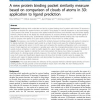ICMLA
2010
14 years 20 days ago
2010
Finding the location of binding sites in DNA is a difficult problem. Although the location of some binding sites have been experimentally identified, other parts of the genome may ...
JCC
1998
14 years 2 months ago
1998
: A novel procedure for docking ligands in a flexible binding site is presented. It relies on conjugate gradient minimization, during which nonbonded interactions are gradually swi...
BMCBI
2007
14 years 2 months ago
2007
Background: Many protein sequences are still poorly annotated. Functional characterization of a protein is often improved by the identification of its interaction partners. Here, ...
BMCBI
2006
14 years 2 months ago
2006
Background: Regulatory modules are segments of the DNA that control particular aspects of gene expression. Their identification is therefore of great importance to the field of mo...
BMCBI
2010
14 years 2 months ago
2010
Background: Prostaglandin H2 (PGH2) is a common precursor for the synthesis of five different Prostanoids via specific Prostanoid Synthases. The binding of this substrate with the...
BMCBI
2010
14 years 2 months ago
2010
Background: Predicting which molecules can bind to a given binding site of a protein with known 3D structure is important to decipher the protein function, and useful in drug desi...
BMCBI
2010
14 years 2 months ago
2010
Background: Structural variations caused by a wide range of physico-chemical and biological sources directly influence the function of a protein. For enzymatic proteins, the struc...
GECCO
2005
Springer
14 years 8 months ago
2005
Springer
Computationally identifying transcription factor binding sites in the promoter regions of genes is an important problem in computational biology and has been under intensive resea...
ICANN
2007
Springer
14 years 9 months ago
2007
Springer
The identification of cis-regulatory binding sites in DNA is a difficult problem in computational biology. To obtain a full understanding of the complex machinery embodied in genet...
WABI
2009
Springer
14 years 9 months ago
2009
Springer
Regulatory antisense RNAs are a class of ncRNAs that regulate gene expression by prohibiting the translation of an mRNA by establishing stable interactions with a target sequence. ...







